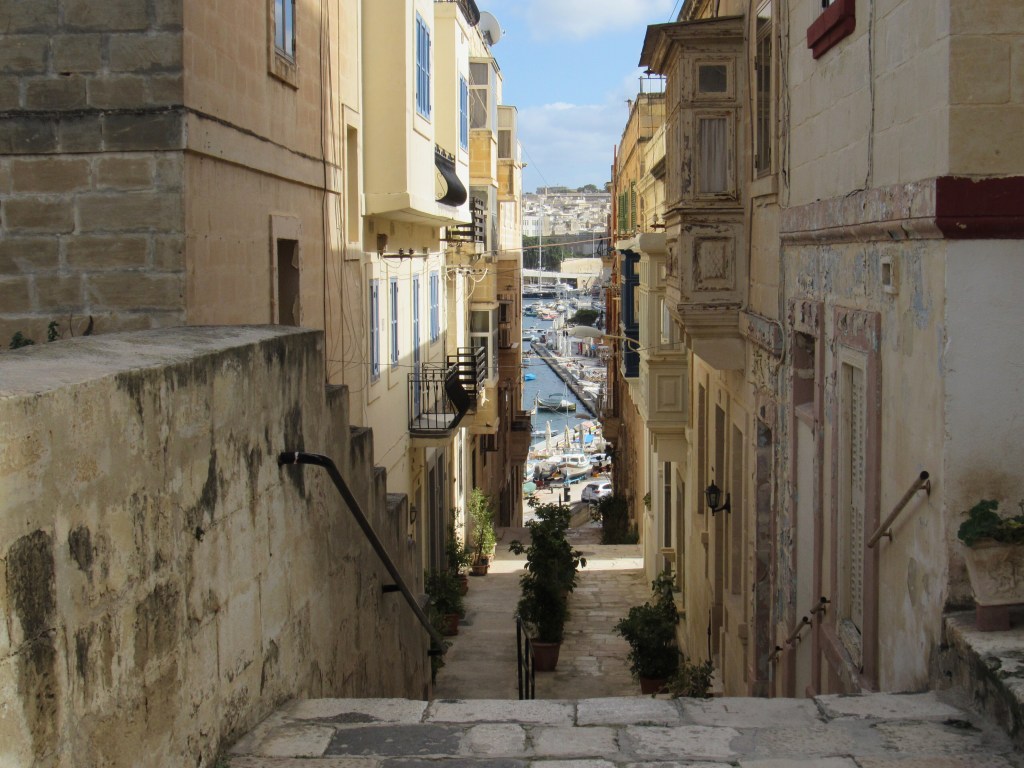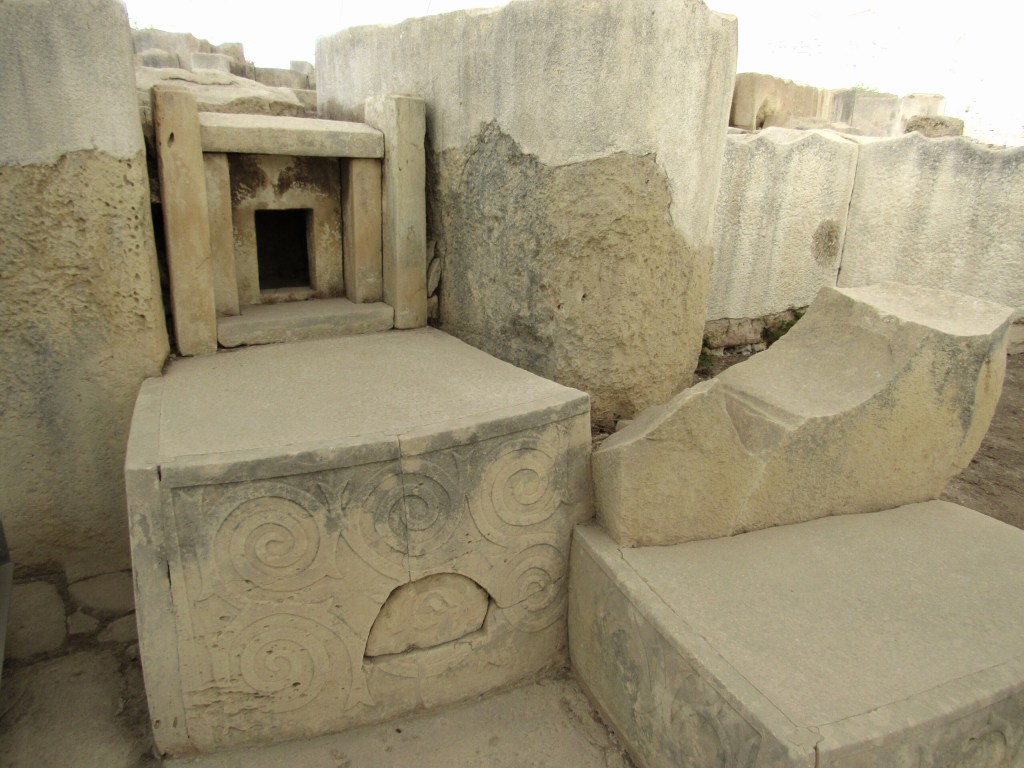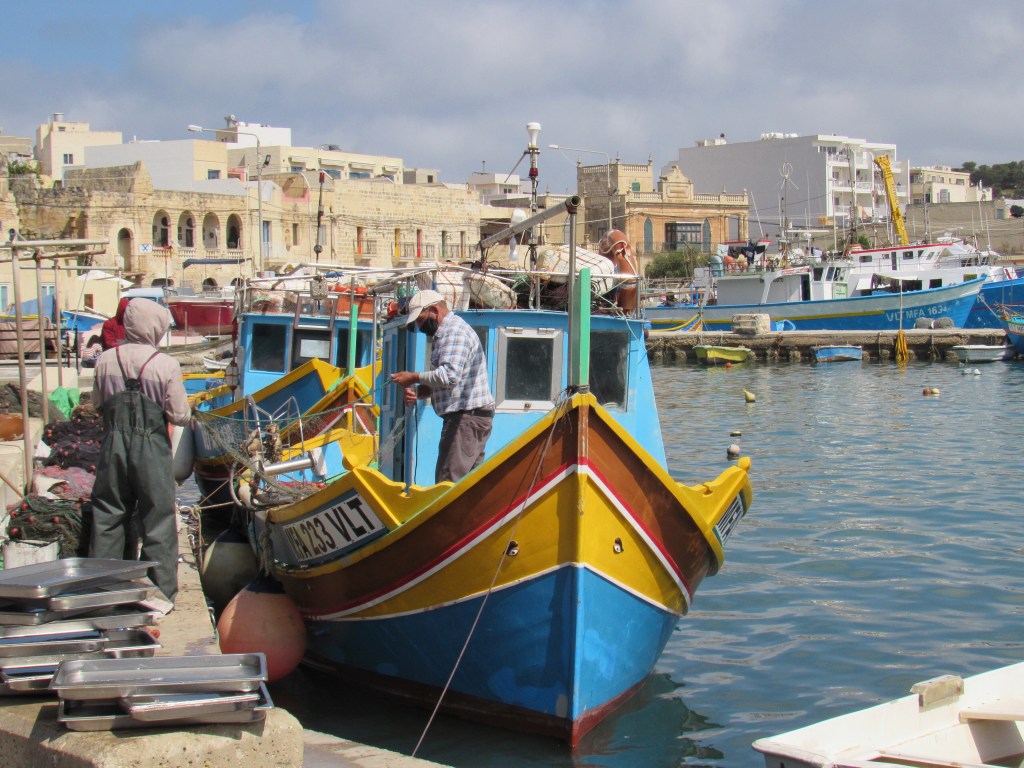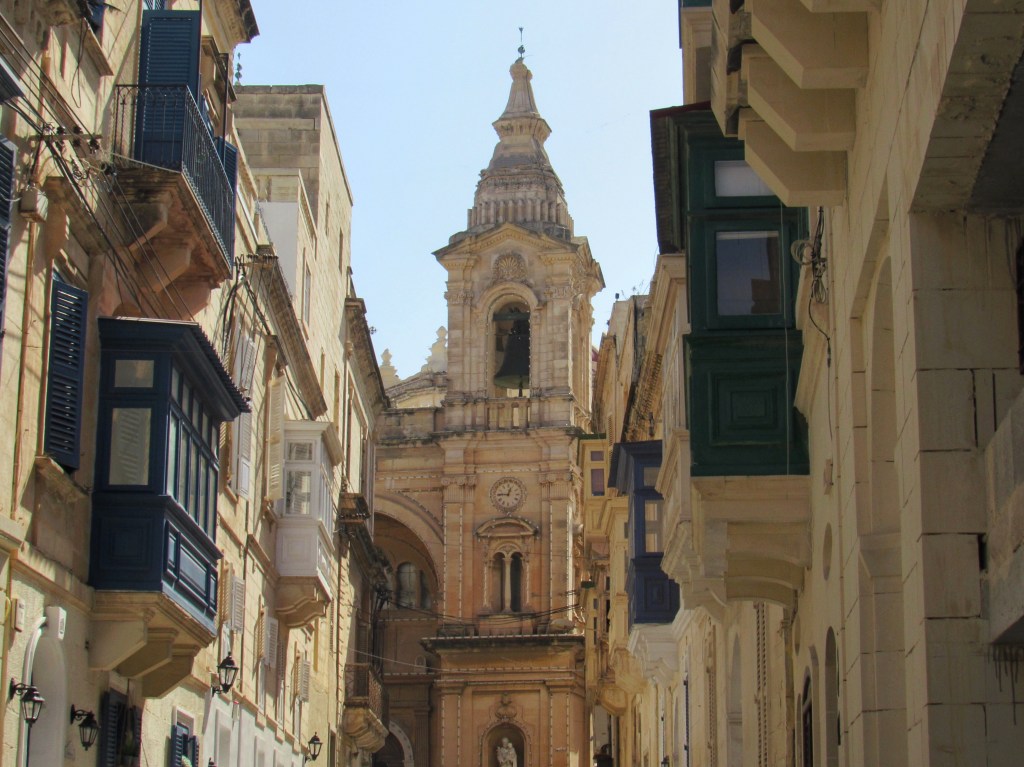When my father’s family migrated to Australia from Scotland in 1927, their ship stopped in Malta. He kept a couple of old photos in his photo tin that always fascinated me. It looked so beautiful and exotic, even in black and white. So, I’d always planned to go to Malta one day. I just hadn’t thought it would be quite so soon.
Trying to get to Australia from Bulgaria during Covid turned out to be a stupid idea. It was a frustrating, stressful, expensive and ultimately pointless waste of energy. With only days left before my time was up in Bulgaria, we had to come up with an alternative plan quick-smart, then JH had the bright idea of Malta. I’d thought an island in the Pacific would be a good place to lay low but, an island in the Mediterranean would do just as well. In fact, it turned out to be even better.
Oh Malta! How do I love thee? Let me count the ways: The stunning architecture, the beautiful Mediterranean Sea, the layer upon layer of fascinating history, the quirky religious icons, the delicious food (and wine), the narrow streets, the quaint balconies, the many things to see and do, the way everything just ‘works’, and perhaps most of all, the friendly happy people.

Malta is blue and gold and beautiful. The honey-gold limestone cliffs and buildings contrast perfectly with the blue sea and sky. Sunlight sparkles on softly rippling water in the colourful harbours and turquoise bays, and friendly little boats (and fancy yachts) bob about merrily. I’ve always loved the Mediterranean. I think it’s the most beautiful sea in the world, a special kind of blue. The sea is ever-present here. It’s there at the end of almost every street, turn the corner and there it is again.

Since Malta is part of the Schengen zone for visas, and Bulgaria isn’t, we could stay for 90 days. We rented a cute little apartment with a glimpse of the sea from the balcony. It’s a few hundred years old, and I think it was once slave quarters. It’s comfortable enough and very convenient, just 114 steps down to the harbour. It’s easy going down, but you notice every one of those steps when lugging the shopping back up.

Our apartment is in Senglea, one of the ‘Three Cities’ that are clustered on tiny peninsulas, just a few minutes ferry ride across the Grand Harbour from the capital of Valletta. This whole area is UNESCO World Heritage and alive with history and charm. It has an authentic community village feeling. There are no big supermarkets, just lots of little shops – grocers, greengrocers, bakers and pastizzerias.

The suburbs surrounding Valletta have one of the highest population densities in Europe. Almost everyone lives in an apartment. The gorgeous older apartment buildings are usually only three to five stories high and often have a garden on the roof. Unfortunately, over-development is rife here and those areas not properly protected are being torn down and replaced with ugly modern high-rise apartment blocks. To fit in with this compact lifestyle, pampered miniature dogs are very popular. There are many beauty salons for dogs. The cats are bigger than the dogs and take no shit whatsoever.

Malta, the country, consists of several small islands. The largest island, also called ‘Malta’, is only 27km long and 14.5km wide. The second-largest island is Gozo, believed to be the home of Calypso, the beautiful sea nymph who allegedly kept Odysseus enthralled for seven years in Homer’s The Odyssey. We took a holiday from our holiday and spent a week in beautiful peaceful Gozo. The third-largest island is Comino. It sits between Malta and Gozo and has a permanent population of two.

The Maltese islands were connected to Sicily until the seas rose at the end of the last great ice age about 12,000 years ago. Sicily is now 80km away across the sea. There’s a ferry for approximately €70. Oh, so tempting! I would definitely be on that ferry if it weren’t for Covid. Around 500km in the other direction is Tunisia and beyond to Africa. I love how everything is so close. Maltese food and language reflect this geographic location, sitting somewhere between Arabic and Italian. It’s officially bilingual here, Malti and English. It makes life so easy for us English speakers. The Maltese code-switch with ease. They begin a sentence in one language and finish it in the other. They tend to have extremely loud, deep, melodious voices and it adds to my happiness to hear them shouting to each other across the balconies.

I adore Mediterranean food, where olives taste like the most delicious things ever (which they often don’t), and sun-dried tomatoes are actually dried in the sun. I think Maltese bread might be my favourite bread ever. It’s coarse-grained, light and fluffy with the crustiest crusts. It’s bread heaven. This traditional sourdough bread has one of the oldest recorded bread histories, dating back to Phoenician times (725-218 BCE). My other favourite Maltese food discoveries are ‘bigilla’ (like a broad bean version of baba ganoush) and ‘pastizzi tal-pizelli’ – little flaky pastry parcels filled with curried mashed peas. They taste so much better than they sound. Oh, and rosé wine from Gozo that tastes like strawberries. Yummo.
For our first two months here, the cafes and restaurants were open, and it was so lovely to sit by the sea, eat and drink, and watch the boats on the water. Leisurely eating is a big part of the culture. I love this lifestyle of the slow-paced savouring of ‘la dolce vita’. I think it would be quite a challenge to be unhappy here. In the last month, Malta has gone into a much tighter virus lockdown, and nothing is open anymore. Now, only two people are allowed outside together.

It’s likely that people have been coming to Malta since well before the seas rose. Spread across the islands are incredible archaeological structures that date from around 4000 BCE. These are called ‘megalithic’ because they were built from huge slabs of limestone. In Maltese folklore, they were created by giants. Like the Ħal Saflieni Hypogeum, some of them are elaborate mass burial chambers, and others, like the Tarxien and Ggantija, are thought to be temples. However, this is all just anthropological conjecture. They may have been venues for big dance parties. I can almost hear the drums.

The beauty of this ancient architecture is astounding, as is the fine detail and lifelike qualities of the carvings and statues. Many of these depict chubby human figures. That’s my kind of people. Remnants of ochre painted animals and spirals can still be seen on the walls and ceilings. They also found thousands of human remains in the burial sites, but I don’t know what happened to these. We were disappointed we didn’t get to see all the ancient bones. The fascinating thing about the culture that built the ‘temples’ is that not much is known about them, and after a couple of thousand years, they just suddenly and completely disappeared. There’s a gap in the archaeological record until the very different Bronze Age people arrived sometime later.

The next few thousand years of Maltese history is a swashbuckling tale of pirates, slave traders, religious zealots, Christian knights and the clashing of empires vying for control of the high seas. These islands have been almost continually occupied by one invader after another, including the Phoenicians, Carthaginians, Romans, Byzantines, Arabs, Normans, Aragonese, the Knights of the Order of St. John, the French under Napoleon and lastly, the British. They all left something behind. It’s a testament to the resilience of the Maltese people that they managed to retain their culture, incorporating some cultural influences from each successive occupier and discarding the rest.

The intriguing Phoenicians bequeathed their boat building skills and the custom of painting eyes on them. It’s such a sensible idea, I think, to have a boat that can see where it’s going.

Christianity came early to Malta. The story goes that St. Paul the Apostle was shipwrecked in Malta around 60 CE. He was being taken to Rome to face trial for annoying the Romans. Paul was from Syria, and although he was around at the same time as Jesus, he never actually met him. Paul and his mates (followers) wrote almost half of the books in the Bible (New Testament), so these are not actually the teachings of Jesus at all, but the personal opinions of this random bloke from Syria.

Malta has a catholic soul. It’s Roman Catholic right down to its bones. I’ve heard it said that even a Maltese atheist is still a catholic. There are churches everywhere, and all are exquisitely beautiful. Many have domes, spires, and bell towers and range from small delicate chapels to immense soaring architectural wonders. I believe that many also have incredible baroque interiors. Sadly, I didn’t see any on the inside, as the churches are all closed due to Covid.

In that almost pagan way of Catholicism, you find statues and icons of Jesus, Mary, and various other saints lurking in every nook and cranny – on street corners, outside (and inside) houses, in caves, alleys and fountains, and even at bus stops. Some are a bit creepy, but most are strangely beautiful.

Perhaps the most unusual historical period is when Malta was ‘gifted’ to the Hospital Knights of the Order of St. John, a medieval multinational catholic order of aristocratic knights. Much of the most beautiful architecture is from this period. The time of the Knights lasted for 250 years (1530-1798) and was a relatively peaceful and prosperous time. Up until then, pirates and slavers were constantly raiding the islands, murdering and carrying people off. The knights built massive walls and fortifications to defend against invasion from the Turkish Ottoman empire. They were successful in protecting the island of Malta. However, 5000 people were captured in Gozo and taken to Tripoli. This must have been almost the entire population of the island.

Malta’s defensive history is highly visible and even for someone like me who has absolutely no interest whatsoever in military shite, it’s hard not to be impressed. The earliest fortifications found are from the Bronze Age (2500-700 BCE), but everyone since then has added defensive layers on top. When Napoleon’s Republican Army invaded in 1798, the Maltese asked the British for help as an enemy in common. Consequently, the French only lasted two years, but it took 150 years to get rid of the British. As a strategic British naval base during the Second World War, Malta experienced the heaviest and most sustained bombing of anyone. They’d been trying to gain independence from Britain since the end of the First World War and finally achieved it in 1964. Malta has now been part of the European Union for almost twenty years.

After WWII, Malta was in a terrible state, and there was a huge exodus. Many people emigrated to Australia, Canada and the US. Maltese communities are a significant part of Australia, and I’m amazed at how many Australians I know who’ve been to Malta. Many links with Australia show up in unexpected ways. It may be one of the few places left that still like Australians.

Although there are many things we didn’t get to do due to Covid restrictions, every day here has been an absolute joy. I feel so lucky we were here in this strange Covid winter with no other tourists. Malta’s winter sunshine and blue sky weather are perfect for me, it’s not too hot and not too cold. If I were Goldilocks, Malta would be Baby Bear’s porridge.
I’ve been steadily working while we’ve been here but still had plenty of time to explore. The public transport system is fantastic with regular buses and ferries all over the place. Every day we walk and walk. There are a lot of hills and a lot of steps. At the weekend, we go somewhere with our new friend Jo and walk some more. It’s been great to have a local to take us places we would never have discovered on our own. Everywhere there is something beautiful and interesting to see.

Our 90 days in the Schengen zone have expired, and I feel like we’ve only just scratched the surface of Malta’s many layers. It took us almost three months to get our paperwork together, and we got married on the 87th day. We really didn’t want to get married at all, but it was the only way to make Bulgaria work as our European base. In the end, it just seemed silly to make life complicated over a stupid piece of paper. We took the ‘no frills’ marriage option for €76, and the whole thing took less than two minutes. There were no rings, name changes, prayers, songs, poems or any of that malarkey. Maybe we can get an annulment once I get my visa. With the pesky marriage certificate in hand, it’s back to Bulgaria for round two. Bring it on!
More Malta photos here.


Oh Jeanne – you have such a gift ! Thankyou for writing with such colour and warmth and bringing Malta alive. Hope all goes well in a Bulgaria. We are fine ! Climbing lots of mountains with my Dutch boyfriend marcel and walking in the bush as much as I can . Maureen is coming to lunch today. Love you Kaz xx🌻🌺🌺
Sent from my iPhone
>
LikeLike
Thanks so much for enjoying and commenting on my posts Kaz xxxx it’s much appreciated 😊. How lovely that Maureen’s coming for lunch. Enjoy and big love to you all ❤️
LikeLike
Great read Jeanne… Malta is now on my list of post covid places to definitely explore 🙂
LikeLike
Thanks Kelly! I loved Malta and I’m sure you will too x
LikeLike
Such an adventure wherever you go! Inspirational historical research made current through your experiences, I feel like I’m there. Your commentary answers the questions I feel I would ask my self if I was actually there. Bravo Adventurous Hermit. BTW thanks for that Howard Street party photo 💐💐😄
Get Outlook for Android
________________________________
LikeLike
Thanks Stella! Malta is such a fascinating place and there was so much to write about that it was difficult to decide what to leave out. Lots of love to you ❤️
LikeLike
Jeannie! What a great piece. I love your style and you’ve done a lot of research to support your impressions. Just a small thing – it was actually the Maltese themselves (not the Knights) who invited the British to oust Napoleon and as you say, it was from the British that the Maltese eventually negotiated their independence. I’m heading out on the third leg of my round Malta walk today and I’m missing my walking companions!
LikeLike
Thanks Jo! I’ve changed it in the post. We had our first vaccine yesterday and feeling a bit rough today. Worth it though. Happy walking! We’ll miss our walks too x
LikeLike
Take care!
LikeLiked by 1 person
Lovely captures!! What a wonderful place it is!!
LikeLike
Thank you 🙂. It certainly is!
LikeLiked by 1 person
Great story Jeanne, very insightful with great historical facts, lovely photos as well. Look forward to going there one day.
LikeLike
Thanks David x It’s such an interesting place 🙂
LikeLiked by 1 person
Well that was just a lovely read! Now I want to go to Malta 🙄. Thanks for that! Ahh you never know.. maybe maybe.. 😊🤷♀️Cheers 👍🏻
LikeLiked by 1 person
Thanks Patty! Yes, you never know 🙂
LikeLiked by 1 person
Love your posts, they’re so evocative.
LikeLiked by 1 person
Thanks Suzie! I hope all’s well with you x
LikeLiked by 1 person
Loved it Jeanne ! I learnt so much about Malta . It indeed sounds like an awesome place. Makes me yearn to travel again so very much. Love to you XXX
LikeLike
Thanks Karyn 🙂. Love you too xxxx
LikeLike
We can so sympathize with you about the struggle to get back to Australia right now. We’ll have to just submit and do the stupid quarantine and waste money soon as we’ll have a little baby to introduce to the family. Life stories aside, looks like you turned a crappy situation into an incredible stay in an unreal destination. We love the look of Malta so much.
LikeLike
A baby! How lovely ❤️. I hope you can get back to Oz soon without too much drama. Europe is opening up now, so you never know. I feel very lucky that we managed to have such an unexpectedly great time in Malta. It’s a fascinating place to spend some time.
LikeLiked by 1 person